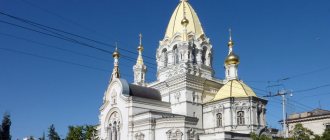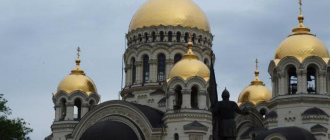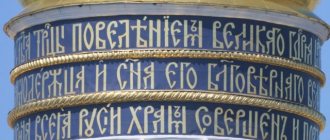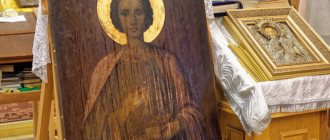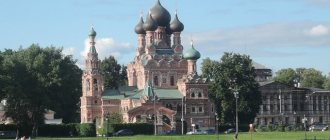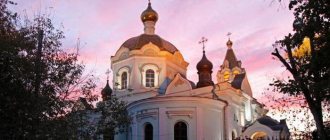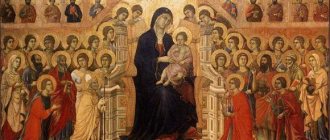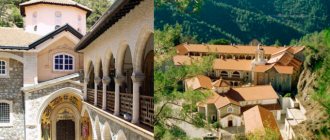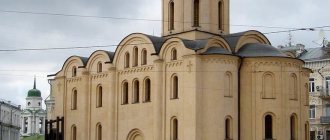For a long time, it has become a tradition in Rus' to celebrate a holiday called the Council of the Archangel Gabriel three times a year (April 8, July 26 and November 21). It was established in honor of the disembodied spirit ─ the servant of God, who brought the Blessed Virgin Mary the news of Her great destiny. In this regard, it becomes clear why one of the days was chosen to be the date following the Feast of the Annunciation, celebrated the day before. The word “cathedral” included in the name of the holiday emphasizes its universality and mass character. On this day, Christians gather together to praise God and His faithful messenger.
Archangel called "God's Fortress"
In order to more consciously read the akathist and prayers during the celebration of the Council of the Archangel Gabriel, we should dwell in more detail on what we know from the Holy Scriptures and Tradition about this representative of the ranks of angels.
First of all, we note that his name ─ Gabriel is translated from Hebrew as “Fortress of God.” In addition, it is generally accepted that among the archangels, who are representatives of the second rank of heavenly spirits (there are nine of them in total), he occupies a position immediately behind Archangel Michael, holding a flaming sword in his hand, and guarding the entrance to the Eden Garden.
Prayers
Troparion, tone 4
(same as to Archangel Michael)
Heavenly armies of the Archangel, / we always pray to you, unworthy, / that with your prayers protect us / with the blood of your immaterial glory, / preserving us, who fall diligently and cry those who are:/ deliver us from troubles, // as the chief of the highest Powers.
Kontakion, tone 8
Blessed and Honest, and Omnipotent, / the most innumerable and terrible Trinity, / you are, Archangel, glorious servant and prayer book, / now pray unceasingly / to deliver us from all sorts of evils d and torment, let us call you: Rejoice, protection of your servant.
In Kontakion, voice 2
In Heaven in vain God’s glory / and on earth from on high giving grace, / to the chief of the Angels, the wise Gabriel, God’s glory to the servant / and peace Divine champion, / save, keep those who cry You yourself be a helper, and no one else is for us.
In Kontakion, voice 2
(same as to Archangel Michael)
Archangel of God,/ servant of the Divine glory,/ leader of angels and teacher of men,/ ask us for what is useful and great mercy,// like the bodiless Archangel.
| Archangel Gabriel. Mosaic approx. 1125-1130 (significantly restored in the 16th century). Eastern apse of the Nativity of the Virgin Mary Cathedral of the Gelati Monastery. |
Mention of Archangel Gabriel in the Old Testament
Every angel is a messenger of something (we note in passing that this is how the word “angel” is translated from Greek), but Archangel Gabriel is entrusted with a special mission - to reveal the hidden meaning of visions and foretell to people the course of future events. In addition, he has many responsibilities. In particular, standing at the Throne of God, he praises the Creator of the Universe and prays for those living on earth.
Among other higher powers of the ethereal world, he commands the Heavenly Army. As is clear from the 1st chapter of the Old Testament Book of Enoch, among other archangels, Gabriel was sent by the Creator to punish the fallen angels. He also inspired the prophet Moses to create the Book of Genesis and revealed to him the future of the Jewish people. However, this is not all of what makes the Cathedral of the Archangel Gabriel one of the most revered holidays among the people.
What do they pray for?
The intercession of the Archangel is resorted to in the following cases:
- in case of harm from magicians, psychics, “healers”, sorcerers;
- in case of harassment and slander;
- in illness;
- with demonic temptation;
- for depression and other psychological disorders;
- during pregnancy, when they are worried about its successful course, about conception and successful childbirth;
- girls ask for a successful marriage.
Archangel Gabriel is the voice of God on earth. He is one of the heavenly ranks especially close to the Creator, and therefore those who flow under the shadow of his wings can hope for the necessary help.
Author: Galina Bocharova
The first New Testament prophecies
It was Archangel Gabriel who appeared to righteous Anna when she indulged in grief over her infertility, and announced to her that her prayer to the Lord had been heard, and soon she would give birth to a Virgin, through whom the Son of God would be incarnated into the world. His words were exactly fulfilled, and after the due date, righteous Anna gave birth to the Blessed Virgin Mary.
When a sermon is heard from the church pulpit on the day of the Council of the Archangel Gabriel, it usually mentions how the Messenger of God invisibly stayed with the Holy Virgin in the Jerusalem Temple during Her adolescence, and then protected her throughout all the days of her earthly life. In such cases, they do not forget to mention how the Archangel Gabriel, appearing to the priest Zechariah, announced that his wife Elizabeth would soon give birth to a son ─ the future John the Baptist. When he doubted the truth of the prophecy, the archangel struck him dumb.
Annunciation to the Immaculate Virgin
However, his main act, which made the feast of the Council of the Archangel Gabriel especially dear to all Orthodox Christians, was the good news he brought to the Blessed Virgin Mary about the conception in Her of the Son of God by the overshadowing and action of the Holy Spirit. Two evangelists narrate this event: Matthew and Luke, and if the first of them is very brief, the second gives a detailed story.
Further, in order to save the immaculate Virgin from the suspicions that arose among her betrothed (formal husband) Joseph, who was unable to comprehend the divine secret with a weak human mind, Archangel Gabriel appeared to him in a dream and announced that the Maiden, having conceived in the womb, remained innocent, since This happened from the action of the Holy Spirit, changing human nature. By this he instilled peace and tranquility in the soul of the righteous elder Joseph, which is also mentioned on the feast of the Council of the Archangel Gabriel.
These facts are interesting
Until recently, the image of the Archangel Gabriel in the company of saints, whom he guided on the true path, was practiced. The icon painters dressed Gabriel himself in rich attire, put a crown on his head, and gave a scepter in his hands.
After the 15th century, the image of the archangel in the company of the Virgin Mary, the queen of angels, became more popular. Gabriel was lucky enough to fulfill the mission of her subordinate. Then they began to draw a lily in his hands, replacing the royal signs with it. This flower has a symbol of purity, it means purity and spirituality.
Sometimes you can hear about the uniqueness of this angel, who is considered a woman. To confirm this, situations from the Bible are cited that indicate special support for children during the process of intrauterine development. But in the official religion, angels have no gender; they are all asexual beings, including Gabriel. Therefore, this version is not accepted.
The news of the Savior's coming into the world
The Holy Evangelist Luke, describing the birth in Bethlehem of the Son of God ─ Jesus Christ, mentions that it was the Archangel Gabriel who appeared to the shepherds guarding the flocks and announced to them about great joy ─ the appearance in the city of David of the Savior, who is destined to deliver all the people of the world from eternal death . He, surrounded by Heavenly warriors, was the first to sing praise to the Almighty, who instills peace and goodwill in the hearts of his children.
The Messenger of God did not leave Saint Joseph the Betrothed in his care even after the birth of Jesus. Sent by the Lord, he appeared to him a second time in a dream and commanded him, together with the Mother of God and her Eternal Child, to flee to Egypt in order to find salvation there from the machinations of the wicked King Herod, who planned to destroy their Holy Family.
The evangelist of the three main gospel events
But this is not all the deeds of God’s Messenger mentioned in the akathist to the Council of the Archangel Gabriel, which is read in all Orthodox churches in Russia. At one of the most dramatic moments of the earthly life of Jesus Christ ─ His prayer in the Garden of Gethsemane, which became the threshold of the torment on the cross, the Lord sent Archangel Gabriel to strengthen His Son. Evangelist Luke describes in detail in chapter 22 how the Messenger of God was constantly next to Jesus, helping him maintain his presence of mind.
Further, this time, all four evangelists report the appearance of the Archangel Gabriel to the Myrrh-Bearing Wives, who appeared early in the morning at the Holy Sepulcher to anoint His venerable body with incense. Despite the fact that their testimonies differ somewhat in listing the participants in this event, they are all unanimous in one thing - at the entrance to the cave, the pious women were met by Archangel Gabriel, who announced the resurrection of the Son of God from the dead. Thus, he appeared as the evangelist of the three main New Testament events associated with the name of Jesus Christ - His conception, birth and resurrection.
And finally, the last episode associated with Archangel Gabriel and described in the New Testament is his appearance to the Blessed Virgin Mary, who came at the end of her life’s journey to the Mount of Olives to pray to Her Eternal Son. Having announced the approach of the day of Her honest Dormition and Ascension into Heaven, he left the Mother of God a bright branch from the Garden of Eden.
Folk signs for April 8
- Autumn will be late if swallows fly too low;
- If it rains in the morning on a holiday, then winter will begin early;
- If there are dark clouds in the sky on April 8, then the weather will be bad;
- If the weather is dry, autumn will be the same;
- If there were frosts on the morning of April 8, then spring will be cool and long.
Subject:
- Holiday
- Church holidays
Miracle revealed on Mount Athos
Everything that was described above is known from the pages of the New Testament, but stories about God’s messenger can also be found in the Holy Tradition. And although they do not sound from church pulpits on the day of the Council of the Archangel Gabriel, Christians have carefully preserved them for many centuries. Let's remember just one of them.
For example, they tell about such an interesting fact, which is directly related to the celebration of the Council of the Archangel Gabriel: the prayer “It is worthy to eat,” read daily by all churchgoers, turns out to have been brought into the world by this very messenger of God. This happened at the end of the 11th century on the holy Mount Athos, where a certain hermit monk and his novice were then fleeing.
Once, when he went to the temple for the all-night service, an unknown elder visited his cell and taught the youth who remained there, who at that hour knelt before the image of the Mother of God, the text of this new, at that time, prayer. So that her words would not be erased from the young man’s memory, the night guest inscribed them with his finger on a stone slab, the surface of which became soft like wax. After that, he disappeared as mysteriously as he had appeared, calling only his name ─ Gabriel. Returning from the all-night vigil and listening to the novice’s story, the monk realized that in his absence the Archangel Gabriel had visited his cell.
Subsequently, the news of the miraculous event spread throughout the world and reached Constantinople. There, to confirm the authenticity of what happened, a stone slab was sent with the text of the prayer “It is worthy to eat,” read since then every day and especially solemnly pronounced on the day of the Council of the Archangel Gabriel. The icon of the Mother of God, in front of which the youth and his night guest prayed, has since also received the name “It is Worthy to Eat.” Her image is given below.
Reverence
In the Jerusalem liturgical tradition for centuries, the memory of the archangels Michael and Gabriel was celebrated on November 14. One of the main centers of veneration of the Archangel Gabriel was Nazareth. There, over the source where, according to legend, the first appearance of Gabriel to the Mother of God took place during the Annunciation, a temple was built in honor of the archangel [4].
| Archangel Gabriel. Mosaic from the 860s, St. Sophia Cathedral, Constantinople. |
In the Byzantine tradition, a common cult of the archangels Michael and Gabriel was established - “Archangels” and “Officers” (Taxiarchs) - although Michael enjoyed special veneration. In Constantinople, there are known churches consecrated in the name of the archangel: in Adda, in Halla (or Chaldai) and in the monastery of Chrysovalantou, as well as a chapel in the New Church of the Great Palace, built by Basil I the Macedonian [5]. However, in the Middle Byzantine period, the tradition of consecrating temples in the name of both archangels prevailed: the churches of the Chief of Officials in Kastoria (c.), Thessalonica (2nd half of the 14th century) and others, the monasteries of the Archangels on Lake Ohrid (c.), in Prilep (c.), are known. -XII centuries), in Lesnov (1341) and others, as well as in honor of the Ethereal Powers in Thessalonica (Rotunda, early century) and in Athens (XI-XII centuries).
| Archangel Gabriel. Icon of the 3rd quarter of the 14th century. Deesis rite of the cathedral church of the Hilendar monastery, Holy Mount Athos |
In addition to the joint celebration of the archangels and the Council of the Ethereal Powers on November 8, in the Constantinople manuscripts from the century around March 26, i.e., the day after the Annunciation, a special holiday of the Council of the Archangel Gabriel appears.
With the spread of the Jerusalem Charter, another celebration of the Council of the Archangel Gabriel was established - July 13. In addition to these celebrations, which have acquired church-wide significance, a local holiday is also known - the Council of Archbishop Gabriel in Adina, celebrated on June 11, in memory of the miraculous revelation of the chant “It is Worthy to Eat” (see more details). In Byzantine literature, there are two texts dedicated separately to the Archangel Gabriel: the encomium and the story of the miracle of the archangel compiled by the monk Luke Adialiptus in the 12th century [6]. A small appendix to the century text of Pantoleon Deacon about the miracles of the Archangel Michael is also dedicated to him [7]. Gabriel usually appears in hagiographic sources together with the Archangel Michael [8]; he is also mentioned in texts dedicated to angels [9].
The Latin literary tradition does not have texts directly dedicated to the Archangel Gabriel. He is mentioned in the “Lists of Milan Saints” [10]. Together with the Archangel Michael, he is depicted as a guard at the entrance to the temple.
In Rus', the Archangel Gabriel may have originally been considered the patron saint of Kyiv. In the Ipatiev Chronicle, under the year 1037, an insert was made about the construction by the blessed Yaroslav the Wise on the Golden Gate of a church in honor of the Annunciation with the goal of “giving always joy to that city with the holy Annunciation of the Lord and the prayer of the Holy Mother of God and the Archangel Gabriel” [11]. About this same church, Saint Hilarion writes: “If the archangel gives a kiss to the Maiden, so will this city be. To it: “Rejoice, rejoice! The Lord is with you!” to the city: “Rejoice, faithful of the city! The Lord is with you!” [12]. In the pre-Mongol period, the name Gabriel was baptized or monastically borne by many Russian princes, including the holy believers Yaropolk Izyaslavich, Vsevolod Mstislavich, Igor Olgovich and Svyatoslav Vsevolodovich.
At the same time, in Rus', the veneration of the Archangel Gabriel remained inextricably linked with the memory of the Annunciation of the Blessed Virgin Mary for quite a long time. At the end of the 12th century, Novgorod Archbishop Gregory (in the world Gabriel) built a church not in the name of his heavenly patron, but in honor of the Annunciation [13]. The oldest temple reflected in written sources, consecrated in the name of the Archangel Gabriel, was built in 1413 in Novgorod, on Khrevkov Street [14]. There is a chapel in the name of the Archangel in the Annunciation Cathedral of the Moscow Kremlin. In the 1530s, a church in the name of the Archangel Gabriel as the heavenly patron of Grand Duke Vasily III was erected in the Kirill Belozersky Monastery [15]. The first mention of the church in the name of the Archangel Gabriel on Chistye Prudy dates back to 1551.
Nowadays, the ancient Jerusalem tradition is preserved in the Alexandrian Orthodox Church, according to which the memory of the archangels Michael and Gabriel can be celebrated on November 14. In other local Orthodox Churches, the Constantinople tradition prevails, according to which the days of veneration of the Archangel Gabriel are November 8, March 26 and July 13. The emphasis in the service on November 8 is on the glorification of the Archangel Michael, but in the hymnographic sequence of this day, some hymns - such as stichera and individual troparia of the canon - are also dedicated to Gabriel. On March 26, the feast of the Annunciation is celebrated and the feast of the Council of the Archangel Gabriel is sung. On July 13, according to the Jerusalem Typicons, the rites of the Archangel Gabriel and the Monk Stephen Savvait or the Monk Joseph of Thessaloniki are united. In Russian Typikons from the 16th century, March 26 and July 13 are considered small holidays of the month.
| Annunciation. Fresco gray III century Catacombs of St. Priscilla, Rome. |
Iconography
Due to his many appearances, most notably the Annunciation of the Blessed Virgin Mary, Archangel Gabriel is probably the most frequently depicted of the angels. In the first centuries of Christian history, his iconography underwent the same changes as the iconography of the entire angelic rank: in the most ancient monuments of catacomb painting, he is indistinguishable from an ordinary person dressed in a tunic and pallium, and then images of Gabriel acquire the characteristic distinctive features of an angel: a youthful face, wings , a halo, a diadem, and often lush court vestments.
Depending on the plot, Gabriel most often holds an orb, a rod, a branch of paradise, or a scroll in his hands. During the period of increasing Roman Catholic influence, such an attribute as the white lily was introduced into the Orthodox iconography of Gabriel - a symbol of the purity and purity of the Virgin Mary. In the West, the lily appears in scenes of the Annunciation no later than a century, in particular in the paintings of Leonardo da Vinci; in the Orthodox environment, this attribute was enshrined in such monuments as “Erminia” by Dionysius Fournoagrafiot, who instructs to write the Annunciation with an archangel who “holds a blossoming lily in his left” [16]. Following another Western tradition, St. Demetrius of Rostov reports that the Archangel Gabriel is depicted “holding in his right hand a lantern with a candle lit inside, and in his left hand a stone mirror made of green jasper, in places with red specks.” According to his interpretation:
The mirror means that St. Archangel Gabriel is the messenger of God's destinies for the salvation of the human race, but the lantern with a candle signifies that God's destinies are hidden until the time of their fulfillment and, upon their very fulfillment, are comprehended only by those who steadily look into the mirror of the word of God and their conscience
[17].
| The Gospel of the Right. Joachim and Anna. Mosaic approx. 1100 in the narthex of the Assumption Church of the Daphne Monastery. |
Archangel-evangelist
A significant part of the images of Gabriel are associated with his ministry as an evangelist. Among the subjects of this group, the most notable are such New Testament events as:
- Annunciation of the Most Holy Theotokos - the Archangel Gabriel is usually depicted in a tunic and himation; his right hand is turned to the Mother of God, and his left holds a staff.
- Nativity of Christ - Archangel Gabriel notifies the shepherds of the birth of Christ [18]; the archangel can be depicted in the host of heavenly powers [19]
- The Annunciation of Archangel Gabriel to Zechariah about the birth of John the Baptist - Archangel Gabriel is often represented as in the plot of the Annunciation of the Blessed Virgin Mary [20]
- Mortal Annunciation of the Mother of God - Archangel Gabriel extends a paradise branch to the Mother of God [21]
| Archangel Gabriel teaches the monk the chant “It is Worthy to Eat.” Icon of the XX-XXI centuries. Greece (?) |
Less common are the plots of the Old Testament appearances of Gabriel, including:
- Instruction by the Archangel Gabriel of the Prophet Moses in the desert - Archangel Gabriel is depicted in front of Moses with a rod and a scroll
- Archangel Gabriel explains the visions of the prophet Daniel - Archangel Gabriel with free hands instructs Daniel [22]
Finally, there are also images showing the acts of Gabriel in the further history of the New Testament Church. The most important among them is the plot of the revelation by the Archangel Gabriel of the chant “It is Worthy to Eat” - the archangel is shown in monastic vestments, writing words on a stone slab.
Sometimes certain plots of apparitions of unnamed angels are associated with the actions of Gabriel. Thus, in a number of monuments the appearance of an angel to St. Pachomius the Great is inscribed as the appearance of the Archangel Gabriel [23].
| The Mother of God on the throne with the archangels Michael and Gabriel. Fresco of Dionysius from 1502 in the Nativity of the Virgin Cathedral of the Ferapontov Monastery. |
Together with other angels
Special veneration of the two most important archangels - Michael and Gabriel, called officials - is reflected in the rich iconographic tradition of their joint depiction. Numerous images show them in the retinue of Christ or the Virgin Mary, around the Cross or Etymasia, on the sides of the central person or object in the image. Their images can be full-length, waist-length, enclosed in medallions, or floating. Except in rare ancient examples, Gabriel is positioned to the left of the central face. There are other stories representing two archangels. For more details, see the section on iconography in the article “official.”
In monumental painting, half-figures of the archangels Michael and Gabriel are sometimes located in the side apses. Gabriel is depicted near the entrance to the temple. Most often in his hands is a stylus and a scroll [24]. In “Erminia” by Dionysius Furnoagrafiot it is indicated that in such cases the scroll should have the inscription: “Holding a cursive cane in my hand, I note the offerings of those entering; I protect the zealous, but I quickly punish the unzealous” [16].
Images of archangels, who are one of the ranks of angelic forces, are included in the iconography of many complex subjects: the Cathedral of the Most Holy Theotokos, “She rejoices in You,” the Last Judgment, “The Queen appears at Your right hand” [25] and others. There are known examples of the inclusion of heavenly powers in theophanic visions, for example, the prophet Ezekiel [26]. The image of the Archangel Gabriel is also present in the compositions “The Cathedral of the Archangel Michael” and “The Cathedral of the Archangel Gabriel” [27].
| Archangel Gabriel. Icon of the 18th century, Moscow. From the local row of the iconostasis of the Moscow St. Gabriel-Arkhangelsk Church (Menshikov Tower). |
In other compositions,
after the Lord Himself and His Most Pure Mother, Archangel Gabriel is the most often depicted face on iconostases. His image is obligatory as part of the Deesis rank of five or more figures, where he is located on the left hand of Christ, after John the Baptist. Gabriel, as a rule, is also written on the royal doors in the plot of the Annunciation of the Blessed Virgin Mary. Finally, he is also often depicted on one of the side altar doors.
In Byzantine art, a number of images of the Archangel Gabriel are associated with the crowning of emperors. Thus, the scenes of the coronation of Emperor Basil I the Macedonian are known, in which Gabriel crowns the king in the presence of the prophet Elijah [28], as well as Emperor Leo VI the Wise, who is crowned by the Mother of God in the presence of Gabriel [29].
In the Russian tradition, there is a semi-figured image of the Archangel Gabriel in a medallion next to the Mother of God on icons associated with the veneration of saints. For example, there is a well-known icon of the Mother of God with the Child of God on the throne and the forthcoming Venerable Sergius of Radonezh from the Makhrishchi Monastery [30], where in the upper left corner the Archangel Gabriel is depicted, prayerfully addressed to the Mother of God and the Child of God. This image is believed to be associated with the dedication of the monastery to the Annunciation, founded by the disciple of St. Sergius - St. Stephen of Makhrishchi.
Among the unique examples of the image of Gabriel on icons, one should note his separate image from 1350 from the Decani Monastery, where the archangel is depicted in lorate vestments, with an orb and a staff in his hands. Also notable is an 18th-century local icon from the Moscow St. Gabriel-Arkhangelsk Church (“Menshikov Tower”), on which the archangel is depicted on the clouds with a sphere in his right hand, raised high, and a flowering branch in his left.
| Archangel Gabriel and Prophet Moses. Miniature 1480-1490. Collection of biblical books. RSL, f. 310, und. No. 1 |
The first two days of memory of Archangel Gabriel
As for the generally accepted days of memory of this disembodied spirit, the messenger of God, who brought messages to the world that became the main milestones in its history, there are three of them, as was said at the beginning of the article. The first of them, March 26 (April 8), is celebrated the day after the Feast of the Annunciation, since Archangel Gabriel is most directly related to it.
The next date ─ July 13 (26) was set in honor of the consecration of the temple dedicated to the Archangel Gabriel in Constantinople four centuries ago, this was also discussed above. Let us note, by the way, that there is a popular belief that if this day turns out to be cold, but without rain, then autumn will be dry and warm.
The history of the appearance of the icon
In total, about twenty original icons of the Archangel Gabriel have survived in the world. Many of them are still part of the collections of Russian museums.
Icon "Angel Golden Hair"
The very first image of the Archangel Gabriel dates back to the second half of the 12th century. The icon is called “Angel of Golden Hair”. Scientists attribute it to the Novgorod school.
The holy face of the archangel was discovered in 1864 by Georgy Dmitrievich Filimonov in a “ruined storeroom” in the Ivan the Great bell tower in the Kremlin. It still remains a mystery how the icon ended up there. After this, the image went to the Rumyantsev Museum. In 1925 it was disbanded, and after a serious restoration in 1930, the face of the archangel was listed in the collections of the Tretyakov Gallery.
Today the icon is kept in St. Petersburg. Here, in the Russian Museum, all conditions for its further preservation have been provided.
Icon "Annunciation of the Blessed Virgin Mary"
This image is one of the most famous. The image is just one of many variations of this biblical story. The icon of the Annunciation dates back to the 16th century. The icon belongs to the Pskov school of icon painting. The image was found in the Church of St. Nicholas the Wonderworker from Usokha in Pskov.
Now the icon is kept in the Pskov State United Historical, Architectural and Art Museum-Reserve.
Icon "Savior Emmanuel"
This image depicts the archangels Michael, Gabriel and Emmanuel. The icon dates back to the 12th century. Comes from the Assumption Cathedral in the Moscow Kremlin. The image was taken from the central iconostasis above the northern gate. Its creator, unfortunately, is not known. At the moment, the icon is kept in the Tretyakov Gallery.
Features of the holiday
For a long time, people have developed many beliefs that determine what can and cannot be done on the feast of the Council of the Archangel Gabriel. Among the deeds recognized as appropriate, one can note general Christian pious deeds, such as a one-day fast on the eve of the holiday, visiting church with reading a prayer appropriate for the occasion, as well as providing all possible help to everyone who needs it. In this case, the requirements do not go beyond the usual norms of behavior of a pious Christian.
Things to avoid doing
The list of prohibitions imposed on this day is quite unique. First of all, it is believed that on November 8 (21) you cannot do two things: cutting with a knife and stabbing with an ax. This is explained by the fact that Archangel Michael, who is honored on the same day, may be offended, since stabbing and chopping is the prerogative of his flaming sword. It is also forbidden to weave, although the reason for this is difficult to find.
However, these prohibitions may be associated with a more ancient belief, according to which on this day a person can be rewarded during his lifetime for the sins he has committed, that is, something unexpected and fatal can happen, for example, some kind of accident. In this regard, it was customary to avoid performing various heavy jobs in which one could, say, overstrain oneself or those that carry the risk of injury.
Of course, exceptions were those types of activities that a person was obliged to perform not of his own free will, for example, official or production duties. This also included deeds that, although involving hard or dangerous work, were aimed at doing something good and pleasing to God. It is only important that selfish goals are not pursued.
What was common to the three days of honoring Archangel Gabriel was the requirement to perform as many good deeds as possible, which, incidentally, applies to all human life.
In non-Orthodox teachings
The memory of Archangel Gabriel is revered by Christians of different confessions. In the Coptic calendar, his memory is listed on December 30 and March 30. In the Roman Catholic Church, the memory was previously celebrated, as well as among the Orthodox, on March 26 (on this day it is still preserved among the Maronites). In many churches, mainly in Spain, his celebration took place on March 18th. However, in 1921, Pope Benedict XV moved the holiday to March 24. Then the memory of Gabriel began to be celebrated on the same day as the archangels Michael and Raphael - September 29. In the Catholic tradition, Archangel Gabriel is considered the patron saint of telecommunications: radio, television, etc.
In later Judaism, the Archangel Gabriel is given a prominent place in Talmudic literature [31].
According to Islamic legends, Gabriel (“Jibril” or “Jabrail”) is the angel closest to Allah, the main one among the four angels (Mikal, Israil, Israfil), the patron of the Prophet Muhammad (2.97 (91) - 98 (92); 66 . 4). Post-Koranic tradition calls him the intermediary spirit who transmitted the Koran to Muhammad. According to another version, the first revelations were conveyed to the prophet by another angel, and Gabriel began to appear to him after the Fatrah (a break in revelations).
| Archangel Gabriel. Icon of St. Andrei Rublev and follower, 1425-1427. From the Deesis rite of the Trinity Cathedral of the Trinity-Sergius Lavra |
